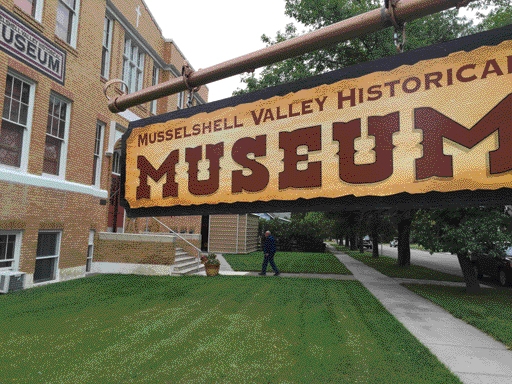In the 1880’s cattle ran wild and free, up and down the broad Musselshell River Valley as the bison had before them. Each spring, cowboys rounded them up, branded them, and tallied the calf crop. In the fall, they gathered the cattle for shipping. They maintained a big corral here on the banks of the Musselshell River, and in 1883, it grew into a trading center they appropriately called Roundup.
Twenty years later, by 1903, homesteaders arrived with their barbed wire fences and ended the days of the open range. In 1907 the Milwaukee Railway came through, and the town adjusted its location accordingly. The Railroad developed coal mines in the nearby Bull Mountains, beefing up the town with new workers.
Obviously Roundup and the Musselshell Valley’s history is diverse and intriguing. Curious individuals traveling through can ask the questions about this valley at the Musselshell Valley Historical Museum in Roundup. As travelers cruise through town, they see a MUSEUM sign about a block off the highway that’s so big, it’s hard to miss. The address is 524 First Street West, and they are open from 1 until 5 seven days a week from May 1 through Sept. They don’t charge admission, but donations are appreciated.
The cattle industry gave the town its name, and Roundup is where the Great Western Roundup of 1989 started its re-enactment in our state’s centennial year. Along with the more distant past, visitors to the museum will see photos and learn about the Great Western Roundup. They may hope they don’t wait 100 years to do it again.
A replica of a coal shaft from the Republic Coal Company tells about this one-time major industry developed near Klein, 2 miles southwest of Roundup. A network of tunnels remain under the Bull Mountains. The volunteer host says that this was high-quality coal, which burned more efficiently than natural gas. Sharing the room with the coal mine shaft are multiple fossils gathered in the area, including ammonites, cephalopods, and other large and small fossilized creatures. Crystals and petrified wood round out the collection.
This valley was a favorite place for Native people, and their culture is acknowledged with a collection of artifacts.
The museum’s main focus is on life in the early days of the town: a dress shop, the hospital operating room, general store, and post office from the small town of Rothiemay. They show a five-room home circa 1890, a one-room school, complete with a teacher and children, and items from the Catholic Church in Klein. Some readers will be interested in the restored John Deere “Johnny Popper,” a two-cylinder, small engine that powered many endeavors in its day.
Outdoor displays include a sheep wagon, blacksmith shop, and the Northfield Cattle Company ranch house. This log cabin was built in 1884 for two British cattle lords.
The museum is housed in a former Catholic school building, which itself is on the National Register of Historic Places. Visitors sign a register from the historic and iconic Adams Hotel in Lavina, Mont. The two-story Adams hotel stood out like a big, white battleship on the prairie and was considered most magnificent when it opened in 1908. One can still see the hotel in Lavina.
The Musselshell Valley Historical Museum in Roundup is a great place to stop on the way to Billings. Visitors get a chance to step back into the past centuries and re-live, for an hour or two, life in the early days of the town. It gives grandchildren a chance to put images to the old family stories and learn a bit of history as well.










